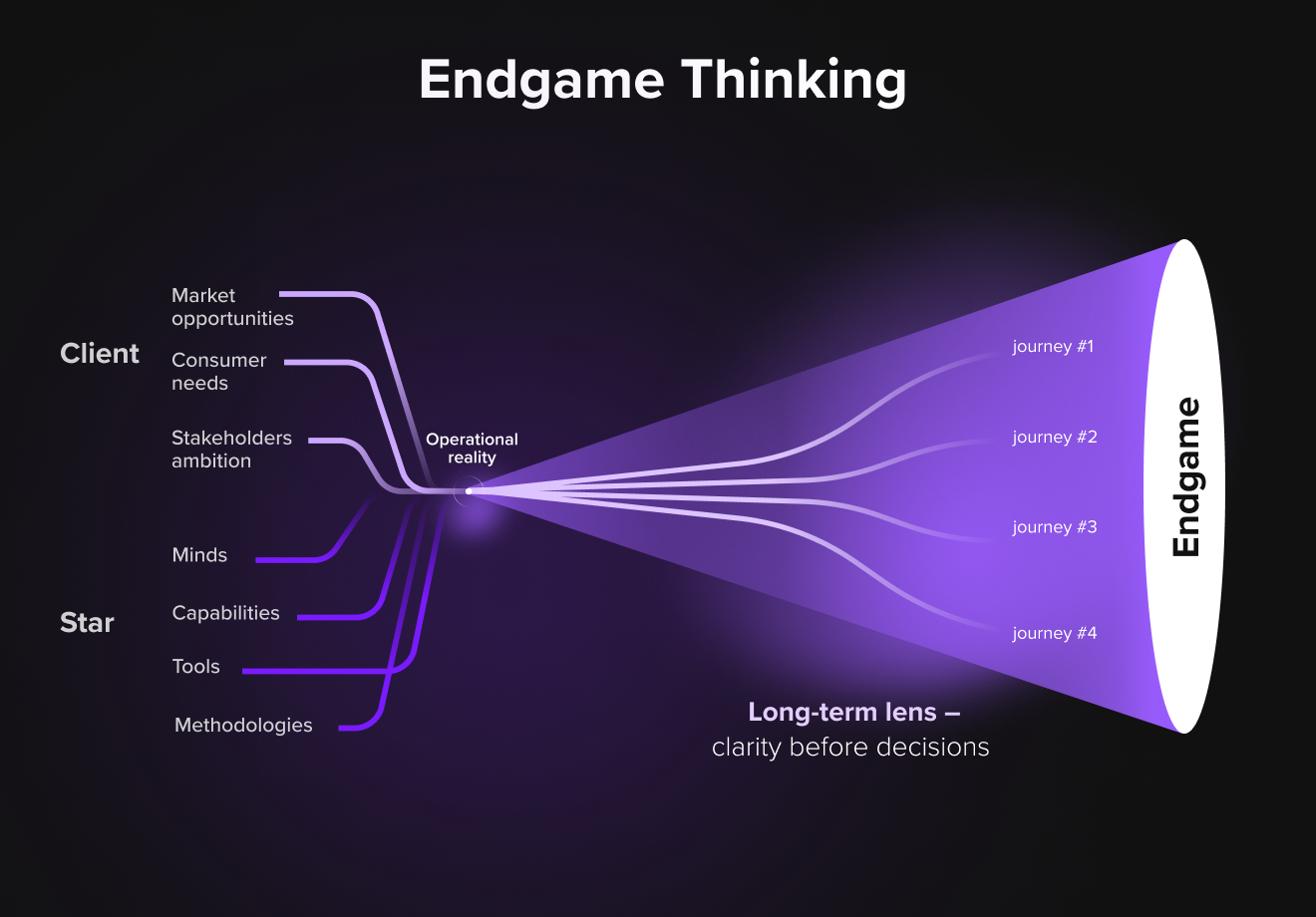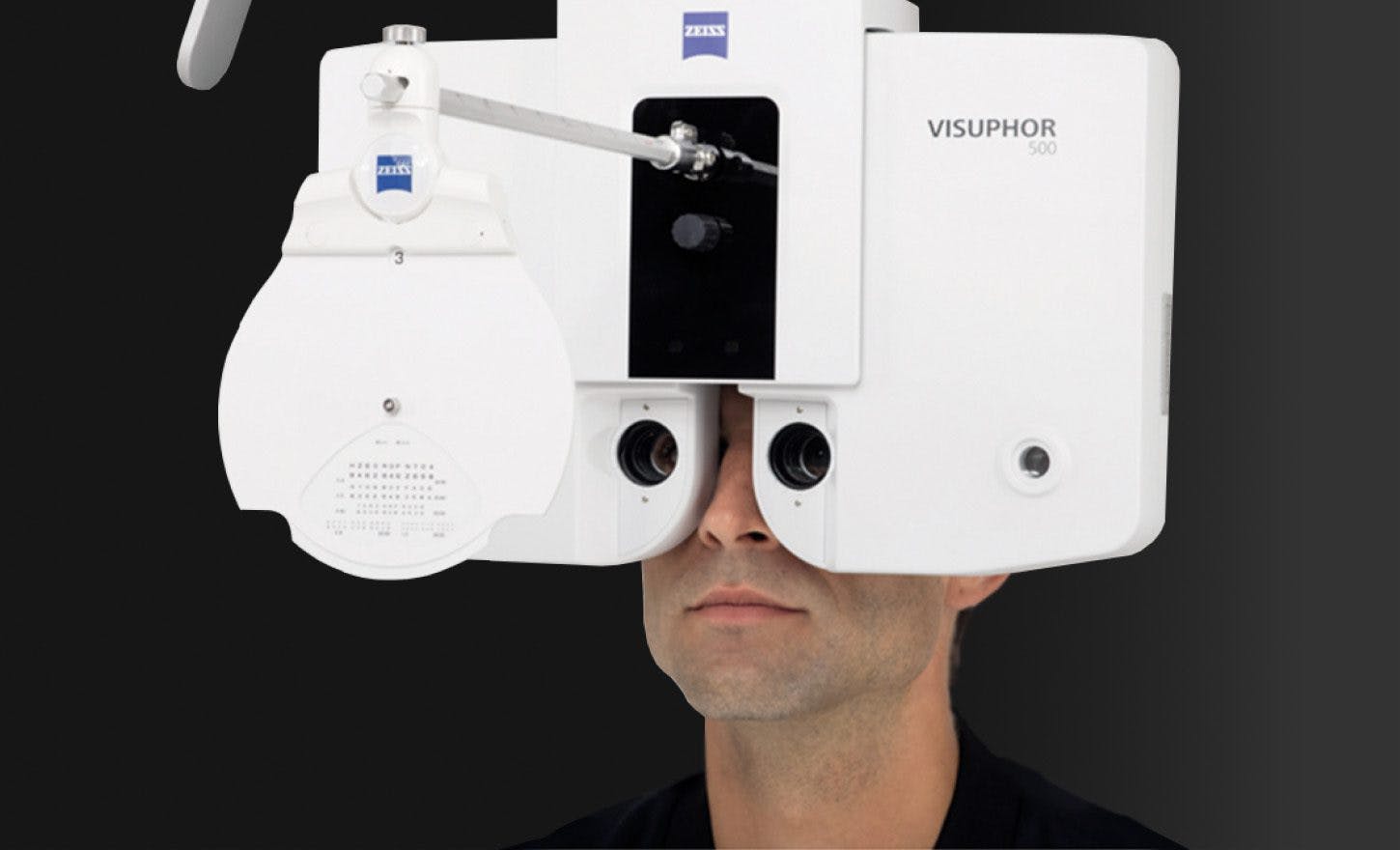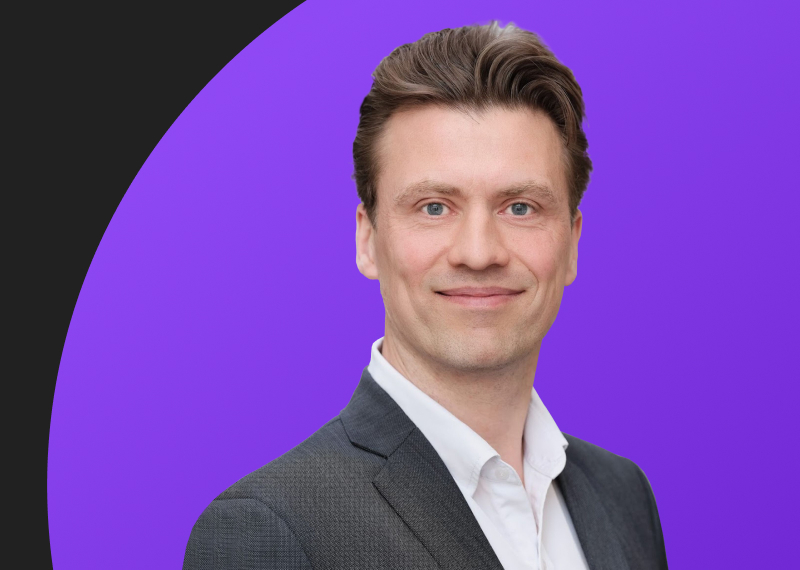Executive summary: Endgame Thinking is a strategic approach that empowers organizations to navigate the complexities of the modern business landscape with agility and foresight, emphasizing the importance of aligning operational strategies with a clear end vision for future success. Developed by business executive & entrepreneur Juha Christensen and operationalized by global consulting firm Star, this methodology provides a comprehensive framework for transforming ambitious visions into actionable strategies, ensuring businesses remain resilient and adaptive amidst market changes and technological advancements.
In the whirlwind of today's global business landscape, where every decision can ripple through your organization in unforeseen ways, C-suite executives stand at the helm, navigating through uncharted territories. What vision do you hold for your organization's future? How do you envision your leadership molding this future, balancing the intricate dance between shareholder expectations and societal contributions? What legacy do you want to leave? How do you capitalize on the potential of AI while investing in human capital? These are not just questions; they are the very dilemmas that define the complexity of modern leadership.
Complexity at the top
Today's C-suite leaders face the complex challenge of balancing the demands for immediate performance outcomes with the strategic imperative of building long-term value for their organizations. This tension is heightened by the increasing pressure to drive growth, enhance shareholder value, and secure a competitive edge through innovation, which may require reimagining existing business models.
Amid these pressures, the diminishing tenure of C-suite executives, particularly CEOs, underscores a shift towards prioritizing short-term results over the pursuit of long-term value creation. This trend towards shorter leadership terms indicates the board's growing expectation for rapid results, complicating the CEO's task of fostering innovation and sustainable growth strategies.
As a result, C-suite executives find themselves at the helm of navigating their companies through the dual demands of achieving quick financial results and ensuring the organization's resilience and relevance through strategic, innovative initiatives. However, the push for immediate results can inadvertently suppress innovative thinking and long-term value creation, which is essential for sustained success.
Endgame Thinking as a new approach
C-suite leaders are at a juncture that calls for more than just traditional leadership skills; it demands a forward-thinking approach that addresses both current challenges and future opportunities. Enter Endgame Thinking – a methodology that bridges the gap between today and tomorrow.
Star's Endgame Thinking is a methodology refined over 15 years with a track record of creating commercial success and transformative products and solutions for more than 900 enterprises and startups, impacting over 500 million users and counting. Its holistic approach has enabled clients to transform their ambitions into actionable plans with tangible results. It is predicated on the integration of strategic foresight with effective implementation, encouraging leaders to think beyond immediate challenges to foresee and plan for future scenarios. Through Endgame Thinking, leaders are equipped to transform their organizational challenges into actionable strategies, crafting a future that is not only envisioned but firmly within their grasp.
The methodology of Endgame Thinking
Endgame Thinking is structured around a series of phases that guide organizations from conceptualization to execution. It is underpinned by a strategic-backwards approach, which means envisioning the ultimate goal first – a clear endgame – and then reverse-engineering the path to get there.
- What is an endgame: An endgame is not an abstract idea; it represents a specific, achievable goal. It encapsulates the point at which a company's success is definitively measured by the value it has created for its end-users. This concept goes beyond the broader mission of a business, focusing instead on tangible outcomes. For instance, while an automotive brand might have the mission to ensure the safety of family journeys, its endgame could be to craft an in-car experience that enhances driver focus. Having a well-defined endgame enables businesses to maneuver through the complexities inherent in their operations. It guides the integration of solutions into the existing framework and infrastructure smoothly, enhancing value and cementing the path to success.
In today's ever-changing business landscape, the adaptability and effectiveness of Endgame Thinking are unparalleled. It empowers organizations to remain agile, responsive, and resilient in the face of disruption. By fostering a culture of strategic foresight and operational excellence, Endgame Thinking enables businesses to not only survive but thrive amidst uncertainty.
The Endgame Thinking playbook
To reach a desired endgame, a well-structured playbook is essential. Endgame Thinking involves the integration of your vision and goals into your organization.
This iterative process involves a comprehensive grasp of your company's current operational landscape, including its resources and capabilities, and aligning these with external market opportunities. It starts with strategic planning to establish long-term goals that resonate with the organization's overarching vision. This phase is crucial for setting key metrics like revenue, margins, and cash flows, which safeguard the company's continuity and future success. Following this, a tactical phase develops actionable plans to turn strategic objectives into practical, achievable steps. The culmination of this process is the implementation phase, where these plans are executed, taking into account the real operational constraints of the business.
By integrating strategic foresight with operational execution, Endgame Thinking helps businesses avoid the common "fail to plan, plan to fail" scenario. It fosters a culture of clear communication, cohesive planning, and aligned execution, ensuring that the company's efforts today are strategically poised to achieve its future ambitions. This approach not only bridges the gap between present actions and future goals but also creates a structured pathway for sustainable growth and value creation, setting the company apart from those stuck in siloed, short-sighted strategies.

- Understanding your operational reality – organizational capabilities and available resources: This introspective step involves candidly evaluating internal processes, technology stacks, and skillsets. The goal is to ensure a precise grasp of the company's current operational strengths and potential constraints. By scrutinizing what is feasible, the devised strategy moves beyond aspiration to become achievable with the available resources.
- Mapping out a sustainable growth trajectory – market opportunity: This step requires a comprehensive view of the current market landscape. It involves identifying emerging trends, untapped needs, and areas ripe for innovation. It's not solely about where the market stands today but also about understanding where it's headed. Companies must position themselves strategically to meet these future developments. Recognizing the right opportunities means aligning the company's strengths with market gaps, utilizing competitive intelligence, and employing foresight to chart a viable path forward.
- Creating value and positive impact – consumer needs: This step extends beyond short-term, opportunistic growth strategies to focus on capitalizing on consumer trends while truly grasping the underlying motivations, pain points, and aspirations of the target audience. It's a process that requires empathy, data analysis, and often direct consumer engagement. By ensuring that the products and services developed are not just desired but genuinely needed by the market, companies align their strategic goals with delivering real value. This approach fosters customer loyalty and drives sustainable growth by placing the endgame at the core of consumer-centricity.
Innovation positions businesses at the cutting edge of their sectors, while strategic foresight equips them to tackle forthcoming hurdles. Operational excellence translates visionary ideas into tangible outcomes, sustaining a company's strategic goals over time. This synergy of elements fosters resilient organizations capable of navigating uncertainties, capturing opportunities, and securing a lasting competitive advantage. Endgame Thinking is distinguished by its iterative nature – the playbook adapts to various scenarios, charting multiple journeys to an endgame, ensuring adaptability.
Mastering the art of strategic foresight and operational excellence in a technology-driven world
By using Endgame Thinking, Star has not only enabled the creation of innovative solutions across various industries but has also solved consumers’ pressing challenges and created new categories and revenue streams. Here are three notable examples.
World’s first-ever digital in-car companion (NIO)
NIO, a leader in China's premium electric vehicle market, enhanced the driving experience with the launch of NOMI, the world’s first in-car AI companion.
Reframe the question: The challenge was not simply to integrate an AI platform into a vehicle but to reimagine it as a digital companion that could enhance the driving experience. This shift in perspective from a functional tool to a companion set the stage for innovation.
Applying Endgame Thinking: Focusing on the desired outcome – a standout user experience that connected emotionally with drivers – Star brought together NIO’s desire for end-users, drivers and passengers, emotional connection and their in-car digital dashboard and crafted a personality for NOMI with voice assistant capabilities that transcended traditional in-car systems. The reimagined NOMI became more than an interface; it evolved into an engaging presence within the car, fostering a relationship with users.
Outcome and ROIs: The introduction of NOMI not only positioned NIO as an innovator but also significantly contributed to its growth – from a $762 million business in 2018 to a $7 billion turnover. NIO's success underscores the power of EGT in driving product innovation and customer satisfaction.
Bridging social disparity with a new credit option (Paidy, now part of PayPal)

Paidy’s transformed 'Buy Now, Pay Later' model into a seamless, accessible solution that propelled the company to unicorn status and led to a landmark acquisition by PayPal.
Reframe the question: The challenge for Paidy wasn't just to provide a payment alternative, but to redefine the 'Buy Now, Pay Later' experience in a market where traditional credit solutions were inaccessible to many consumers without credit scores.
Applying Endgame Thinking: The strategy was to craft a frictionless, trustworthy experience. This approach involved deeply understanding consumer barriers to credit and leveraging technological innovation to offer a simple, secure, and personal transaction process, leading to rapid adoption and significant market disruption.
Outcome and ROIs: The successful implementation of this vision led to Paidy's rapid growth and its acquisition by PayPal for US$2.7 billion. This move not only validated Paidy's market impact but also underscored the potency of a well-defined endgame in driving substantial business value and user-centric innovation.
Digitizing eyecare (ZEISS)

ZEISS addressed the accessibility challenges in vision care through the creation of the ZEISS VISU360 telemedicine platform. This platform connected patients with optometrists remotely, optimizing user experience and expanding access to healthcare services.
Reframe the question: ZEISS reimagined the patient experience in eye care, transforming the challenge of physical availability into an opportunity for digital innovation with the VISU360 telemedicine platform, aiming to make eye care more accessible and efficient.
Applying Endgame Thinking: ZEISS and Star collaboratively focused on a seamless user experience for both patients and optometrists. The platform was designed to not only facilitate eye exams remotely but also to ensure ease of use and build trust, thereby integrating healthcare with technology to bridge access gaps.
Outcome and ROIs: The outcome was the award-winning ZEISS VISU360 platform, which led to a significant increase in the company's revenue and market share. By prioritizing user needs and a frictionless experience, ZEISS advanced its position in the market, demonstrating the tangible benefits of strategic, user-centric innovation in healthcare.
The origin of Endgame Thinking
Juha Christensen, Chairman of the global consultancy Star and the renowned Danish company Bang & Olufsen, developed the concept of Endgame Thinking from a combination of personal and professional experiences. Growing up in Denmark, a country where design transcends aesthetics to become a fundamental part of daily life, Juha absorbed the principle that thoughtful design profoundly influences human interaction with the environment. This appreciation for design was complemented by his grandfather’s life-long dedication to craftsmanship making handrails, which taught him the value of precision and detailed planning. In addition, his parents’ entrepreneurial endeavors highlighted the importance of transforming visions into actionable steps at a young age.
This blend of influences led Juha to conceive Endgame Thinking as a vital strategy for navigating the complexities of business innovation and digital product development throughout his career. Recognizing the challenges entrepreneurs and business executives face in bringing concepts to successful fruition in his early career, Juha saw the necessity for a methodology that not only facilitated the design and development of products but also ensured their alignment with a strategic vision that could captivate investors.
As a global consulting firm, Star practices Endgame Thinking by providing strategic maps to clients that guide their businesses through the ebbs and flows of their industry. These are not just theoretical documents; they are pragmatic guides that tell leaders how to move from one stage to the next, ensuring that they reach where stakeholders envision the company to be.
Endgame Thinking fosters a disciplined focus, ensuring that businesses do not lose sight of their ultimate goals amid their daily operations and short-term targets. In addition, it instills a culture of discipline, encourages proactive and adaptable mindsets, and promotes collaboration across all functions of the organization. As the endgame is fixed, this methodology remains dynamic enough to accommodate market shifts and turns, ultimately driving customer retention and increasing shareholder value.
What’s next
Endgame Thinking was born with the mission to empower organizations to foresee and navigate the future confidently. In the face of a stagnant global economy and uncertainties, Star's comprehensive support for clients, including identifying their optimal business journeys, can stimulate growth and foster significant commercial and technological advancements.
This approach could also serve as a remedy for the recent decrease in funding and higher interest rates, providing much-needed support for startups and mature enterprises striving for success.
By embracing Endgame Thinking, we invite organizations to not just envision a future of success but to actively construct it, turning today's challenges into tomorrow's triumphs and redefining what's possible in an ever-evolving world.





